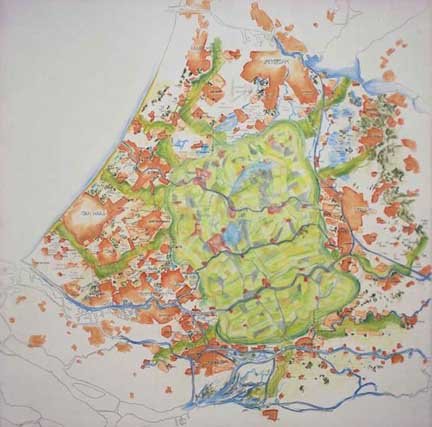A Vision for the Green Heart of Holland, 1984
INSTALLATION AT GOUDA
THE MAP PRINTED BACKWARDS. THE GREEN HEAR SPLITS ON THREE WHEN SEVERAL HUNDRED THOUSAND HOUSES ARE DRAWN IN
THE FIRST PROPOSAL. WHERE THE GREEN HEART IS DEFINED BY A BIODIVERSITY RING AND THE CITIES DIVIDED BY PARK LANDS.
WHERE IT IS DISCOVERED THAT THERE IS AMPLE SPACE FOR MORE THAN 600,000 HOUSES EXTERNAL TO THE GREEN HEART.
WHERE 12 YEARS LATER THE GREEN HEART STORY IS ADOPTED AS ONE OF SEVEN SUSTAINABLE OPEN SPACE REGIONS IN NORTH WEST EUROPE.
DESIGN FROM THE FINAL REPORT OF SUSTAINABLE OPEN SPACE IN NORTH WEST EUROPE
A Vision for the Green Heart of Holland, 1995. At the request of the Cultural Council of South Holland, we undertook a consideration of the Green Heart. Beginning with an appreciation of the appropriateness of the metaphor embedded in the naming “green heart,” we searched for its meaning and its identity. The Green Heart can be seen as a vast farm centering a ring of cities, Amsterdam, Rotterdam, Utrecht, et al. Its landforms represent the history of Holland. It is a landmark by which the rest of the world recognizes Holland. It can be seen as a great central park for this ensemble of cities, which in turn are an economic and cultural center in Europe. But the Green Heart is now facing encroachment from without and development from within. Its value in 1994-5 was being debated, its identity questioned, its very existence threatened.
In responding to this situation the Harrison Studio constructed a series of images–part ceramic tile, part map, part drawing, part video and part discourse. They proposed a new vision for the Green Heart and the Randstad of Holland. In the proposal new boundary conditions emerged that would clarify the roles of the urban, the ecological and the farming communities which altogether comprise a major part of the landscape of Holland.
The piece has a number of concepts embedded in a single image that
1. Gives an identity to the 800 square km area of the Green Heart
2. Establishes a form that encourages biodiversity in the urban, suburban and agricultural communities
3. Establishes the conditions that preserve the identity of the round of cities – Den Haag, Utrecht, Amsterdam ET. al.
4. Redirects the vast $200 billion economic engine that was coming into being in this area due to the planning requirement for 600,000 houses and the concomitant infrastructure.
Outcomes
The majority of the issues raised and proposed in the Green Heart exhibition were expressed in the Minister of the Environment’s proposal for Holland in 1995. A new government came in and the proposal was shelved until 1999. The work was re-exhibited and presented by the Ministry of Agriculture, Environment and Forestry in 1999. The concepts in these works are in the government plan and being enacted, with modifications. Essentially the line made in the image defining the Green Heart has become the official line on the present Dutch maps. In 2005 the Final Report for Sustainable Open Space in North West Europe funded by the European Regional Development Group declared the Green Heart of Holland one of the seven most valuable open spaces in this large region and in need of continued protection.
Where: Gouda, The Netherlands
When: 1994-1995
Who: The Harrison Studio Gouda.
Designers: Gabriel Harrison, Vera Westergaard
Project Manager: Martin Von Weisemal.
Landscape Architect: Rimmer DeVries.
Commissioned by: Cultural Council of Southern Holland and the Province
of South Holland, Adrian de Regt, Director





